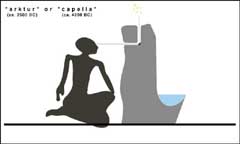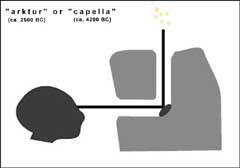|
Now Herouni steps into the fray, armed with calculations and methodology
borrowed directly from Parsamian's study at Metsamor.
As
Herouni and his team catalogued the stones, they found one that
was different from the rest. Herouni believes it is the
key stone Parsamian was looking for. "All the stones with
apertures point to the horizon or lunar positions in the night
sky," he says. "All, that is, but one."
"While other
sight holes pointed to the horizon, this one had an aperture
that bent in the center and pointed directly up. You couldn't
see anything looking through that aperture, but if you put something
shiny at the bend, something like a polished metal or obsidian,
you could look through the hole to a zenith point straight above
you. It was a periscope." 
Herouni
excitedly began to make calculations from this unique stone.
Figuring the ancients looked at specific star or constellation
through the periscope, he knew he had the key Parsamian was
looking for to be able to date the site.
"The chances
of something like that occurring are very small," Herouni said.
"Mathematically I was certain it would lead to one star or group
of stars in the sky, and then we would have our date."

Herouni
was able to discount the sun or moon, since they do not cross
the zenith point above the stone at that latitude. At
the same time, because of the tilting axis of the earth as it
rotates around the sun, the stars change their apparent position
in the night sky, something Herouni calls a "delivered rotation
to the elliptical plane by 23 degrees, with a conical precision
of 26,000 years," he knew that what appeared at
the zenith could only be a star or stars. Figuring that
even with a polished object as a reflective mirror, the ancients
would not have been able to observe any distant stars, Herouni
chose to study the brightest stars in the North sky for his
calculations.
Using the
same method Parsamian had published in her study on Metsamor,
Herouni took the latitude of the site, five of the brightest
stars in the North sky, and compared them with a stellar calendar
showing the stars ascendant in Sissian region during different
epochs of time.
"The probability
of one of these stars crossing the zenith at that point was
very low. I expected to find at most one star, or one
group of stars."
What shocked
Herouni when he completed his calculations was that he not one
star at the zenith above the stone, he found two. "The
star calendar showed there was a 100% probability of the stone
pointing to two stars," Herouni said, "each at different times.
The chances of it actually pointing to two stars is infinitesimal."
The two
stars are Arktur and Capella.
"The interesting
thing is that Arktur was ascendant at the time the old or "main"
style Armenian calendar began (2492 BCE). Now this would
make the site a few hundred years younger then that at Metsamor,
but I believed it had to be older, for several reasons, not
the least of which is that by the time of Metsamor, the astronomers
were already drawing star positions and geometric figures on
stone. It looks like they were mapping the night sky on
their observatory site. But we have found no inscriptions
at the Sissian site. There had to be advancements in the
culture to reach Metsamor's sophisticated level."
|